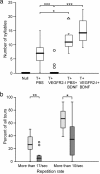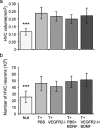Brain-derived neurotrophic factor signaling in the HVC is required for testosterone-induced song of female canaries
- PMID: 20007475
- PMCID: PMC3377376
- DOI: 10.1523/JNEUROSCI.2564-09.2009
Brain-derived neurotrophic factor signaling in the HVC is required for testosterone-induced song of female canaries
Abstract
Testosterone-induced singing in songbirds is thought to involve testosterone-dependent morphological changes that include angiogenesis and neuronal recruitment into the HVC, a central part of the song control circuit. Previous work showed that testosterone induces the production of vascular endothelial growth factor (VEGF) and its receptor (VEGFR2 tyrosine kinase), which in turn leads to an upregulation of brain-derived neurotrophic factor (BDNF) production in HVC endothelial cells. Here we report for the first time that systemic inhibition of the VEGFR2 tyrosine kinase is sufficient to block testosterone-induced song in adult female canaries, despite sustained androgen exposure and the persistence of the effects of testosterone on HVC morphology. Expression of exogenous BDNF in HVC, induced locally by in situ transfection, reversed the VEGFR2 inhibition-mediated blockade of song development, thereby restoring the behavioral phenotype associated with androgen-induced song. The VEGFR2-inhibited, BDNF-treated females developed elaborate male-like song that included large syllable repertoires and high syllable repetition rates, features known to attract females. Importantly, although functionally competent new neurons were recruited to HVC after testosterone treatment, the time course of neuronal addition appeared to follow BDNF-induced song development. These findings indicate that testosterone-associated VEGFR2 activity is required for androgen-induced song in adult songbirds and that the behavioral effects of VEGFR2 inhibition can be rescued by BDNF within the adult HVC.
Figures





Similar articles
-
Regulatory mechanisms of testosterone-stimulated song in the sensorimotor nucleus HVC of female songbirds.BMC Neurosci. 2014 Dec 2;15:128. doi: 10.1186/s12868-014-0128-0. BMC Neurosci. 2014. PMID: 25442096 Free PMC article.
-
Reversing song behavior phenotype: Testosterone driven induction of singing and measures of song quality in adult male and female canaries (Serinus canaria).Gen Comp Endocrinol. 2015 May 1;215:61-75. doi: 10.1016/j.ygcen.2014.09.008. Epub 2014 Sep 26. Gen Comp Endocrinol. 2015. PMID: 25260250 Free PMC article.
-
Aromatase inhibition affects testosterone-induced masculinization of song and the neural song system in female canaries.J Neurobiol. 2003 Feb 5;54(2):370-9. doi: 10.1002/neu.10141. J Neurobiol. 2003. PMID: 12500312
-
Testosterone modulation of angiogenesis and neurogenesis in the adult songbird brain.Neuroscience. 2013 Jun 3;239:139-48. doi: 10.1016/j.neuroscience.2012.12.043. Epub 2013 Jan 3. Neuroscience. 2013. PMID: 23291451 Free PMC article. Review.
-
Birth, migration, incorporation, and death of vocal control neurons in adult songbirds.J Neurobiol. 1997 Nov;33(5):585-601. J Neurobiol. 1997. PMID: 9369461 Review.
Cited by
-
Neurogenesis in the adult avian song-control system.Cold Spring Harb Perspect Biol. 2015 Jun 1;7(6):a019000. doi: 10.1101/cshperspect.a019000. Cold Spring Harb Perspect Biol. 2015. PMID: 26032719 Free PMC article. Review.
-
Testosterone treatment reveals marked sex differences in song diversity and syllable syntax in adult canaries.Res Sq [Preprint]. 2023 Apr 11:rs.3.rs-2755085. doi: 10.21203/rs.3.rs-2755085/v1. Res Sq. 2023. Update in: Biol Sex Differ. 2023 Aug 1;14(1):49. doi: 10.1186/s13293-023-00533-8. PMID: 37090598 Free PMC article. Updated. Preprint.
-
Using the canary genome to decipher the evolution of hormone-sensitive gene regulation in seasonal singing birds.Genome Biol. 2015 Jan 29;16(1):19. doi: 10.1186/s13059-014-0578-9. Genome Biol. 2015. PMID: 25631560 Free PMC article.
-
From silence to song: Testosterone triggers extensive transcriptional changes in the female canary HVC.J Neuroendocrinol. 2025 Jun;37(6):e13476. doi: 10.1111/jne.13476. Epub 2024 Dec 8. J Neuroendocrinol. 2025. PMID: 39647995 Free PMC article.
-
Undirected (solitary) birdsong in female and male blue-capped cordon-bleus (Uraeginthus cyanocephalus) and its endocrine correlates.PLoS One. 2011;6(10):e26485. doi: 10.1371/journal.pone.0026485. Epub 2011 Oct 19. PLoS One. 2011. PMID: 22039498 Free PMC article.
References
-
- Berton O, McClung CA, Dileone RJ, Krishnan V, Renthal W, Russo SJ, Graham D, Tsankova NM, Bolanos CA, Rios M, Monteggia LM, Self DW, Nestler EJ. Essential role of BDNF in the mesolimbic dopamine pathway in social defeat stress. Science. 2006;311:864–868. - PubMed
-
- Bolhuis JJ, Gahr M. Neural mechanisms of birdsong memory. Nat Rev Neurosci. 2006;7:347–357. - PubMed
-
- Cao L, Jiao X, Zuzga DS, Liu Y, Fong DM, Young D, During MJ. VEGF links hippocampal activity with neurogenesis, learning and memory. Nat Genet. 2004;36:827–835. - PubMed
Publication types
MeSH terms
Substances
Grants and funding
LinkOut - more resources
Full Text Sources
